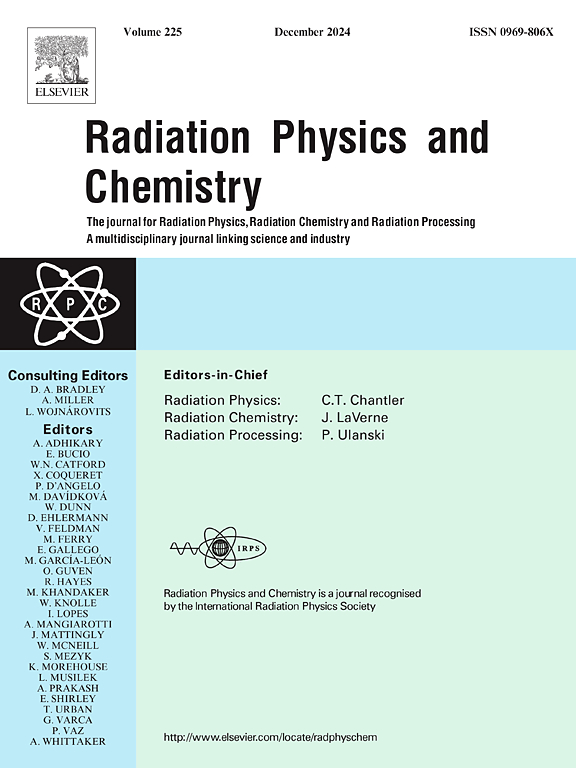Dispersion patterns of scattered radiation exposure on phantom in CT fluoroscopy
IF 2.8
3区 物理与天体物理
Q3 CHEMISTRY, PHYSICAL
引用次数: 0
Abstract
Introduction
Working with CT fluoroscopy for diagnoses and therapeutics potentially exposes radiology nurses to ionising radiation. This study aims to estimate the dispersion patterns of scattered radiation doses received by operators during CT fluoroscopy.
Methods
An anthropomorphic phantom was exposed to radiation through constant CT fluoroscopy workflow and protocols. Images were obtained per exposure without gantry tilt, 30° gantry tilt in the caudal and 30° in cranial directions. A survey meter was used to detect the scattered radiation doses, which were recorded in millisieverts per hour (mSv/h) with specific distances from the phantom's isocentre in x- (lateral from the isocentre), y- (above the isocentre), and z-directions (anterior and posterior from the isocentre). A survey was conducted to record the most preferred self-positioning of the staff nurses during the procedures. Logarithmic transformation was performed to normalise the measured dose values. The correlation between the radiation dose fall off with distances to the isocentre was evaluated. A generalised linear mixed model (GLMM) was conducted to examine the effects of gantry tilt, height from the floor, and absolute distances from the isocentre on the dose reduction, accounting for variability between the cluster positions.
Results
Heatmaps of the dose dispersion pattern were produced, showing that there were moderate negative correlations between scattered radiation and distances to the isocentre. The GLMM analysis showed that gantry tilt, height from the floor, and absolute distance from the isocentre were significant predictors of Log D variation (p < 0.001). Higher Log D values were associated with a 0o gantry tilt and 30o cranial tilt, as well as heights of 102 cm and 142 cm compared to 182 cm. Pairwise comparisons indicated significant differences in Log D across gantry tilts and heights, with interaction effects showing a monotonic reduction in Log D from 0° to 30° cranial and caudal tilts, particularly at 142 cm and 182 cm heights. The majority of the staff nurses would station themselves closest to the isocentre during the procedure.
Conclusion
This study highlights the influence of gantry tilt, height, and distance from the isocentre on scattered radiation distribution during CT fluoroscopy. The heatmap from this study could be used as a guide for staff nurses to position themselves in the CT room during imaging procedures and support a radiation-safe working environment.
CT透视中虚影上散射辐射暴露的色散模式
导言使用 CT 透视进行诊断和治疗可能会使放射科护士受到电离辐射。本研究旨在估算操作人员在 CT 透视检查过程中接受的散射辐射剂量的分散模式。每次曝光获得的图像均无龙门倾斜,龙门向尾部倾斜 30°,向头颅倾斜 30°。使用测量仪检测散射辐射剂量,以毫西弗/小时(mSv/h)为单位记录与模型等中心的特定距离,分别为 x-(等中心外侧)、y-(等中心上方)和 z-(等中心前方和后方)。我们进行了一项调查,以记录护士在手术过程中最喜欢的自我定位。对测量的剂量值进行对数变换,使其正常化。评估了辐射剂量下降与等中心距离之间的相关性。通过广义线性混合模型(GLMM)研究了龙门架倾斜度、距地面高度和与等中心的绝对距离对剂量降低的影响,并考虑了集群位置之间的差异。GLMM 分析表明,龙门倾斜度、距地面高度和与等中心的绝对距离是对数 D 变化的重要预测因素(p < 0.001)。与 182 厘米相比,较高的对数 D 值与 0o 的龙门倾斜和 30o 的头颅倾斜以及 102 厘米和 142 厘米的身高相关。配对比较表明,不同龙门倾斜度和高度下的 Log D 存在显著差异,交互效应显示 Log D 从 0° 到 30° 头颅和尾部倾斜度单调降低,尤其是在 142 厘米和 182 厘米高度时。这项研究强调了龙门架倾斜度、高度和与等中心的距离对 CT 透视过程中散射辐射分布的影响。这项研究得出的热图可用作护士在 CT 室进行成像程序时的定位指南,并有助于营造辐射安全的工作环境。
本文章由计算机程序翻译,如有差异,请以英文原文为准。
求助全文
约1分钟内获得全文
求助全文
来源期刊

Radiation Physics and Chemistry
化学-核科学技术
CiteScore
5.60
自引率
17.20%
发文量
574
审稿时长
12 weeks
期刊介绍:
Radiation Physics and Chemistry is a multidisciplinary journal that provides a medium for publication of substantial and original papers, reviews, and short communications which focus on research and developments involving ionizing radiation in radiation physics, radiation chemistry and radiation processing.
The journal aims to publish papers with significance to an international audience, containing substantial novelty and scientific impact. The Editors reserve the rights to reject, with or without external review, papers that do not meet these criteria. This could include papers that are very similar to previous publications, only with changed target substrates, employed materials, analyzed sites and experimental methods, report results without presenting new insights and/or hypothesis testing, or do not focus on the radiation effects.
 求助内容:
求助内容: 应助结果提醒方式:
应助结果提醒方式:


